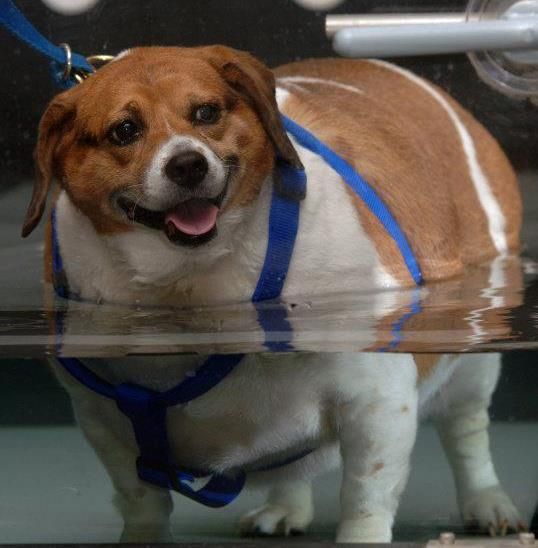By Jodi Bryson for The Dog Daily
 Studies show that working out with a friend increases the odds that you'll stick with a fitness regimen. And who's one of your best buddies, one that could probably use a good workout too? That's right, your trusted canine companion, the one that that eagerly anticipates spending quality time with you. We all know how easy it is to ignore the willful inner voice that wants you to hit the gym, but it's not so easy to ignore your dog's sweet furry face, pleading whimpers and wagging tail.
Studies show that working out with a friend increases the odds that you'll stick with a fitness regimen. And who's one of your best buddies, one that could probably use a good workout too? That's right, your trusted canine companion, the one that that eagerly anticipates spending quality time with you. We all know how easy it is to ignore the willful inner voice that wants you to hit the gym, but it's not so easy to ignore your dog's sweet furry face, pleading whimpers and wagging tail.
Nationwide, there are many dog gyms, spas and physical therapy facilities, as well as dog-specific classes at typically humans-only sports gyms. "Many of the workouts are designed for the dog only, or are rehabilitative for dogs that are in physical therapy, such as the treadmill or water aerobics," says Gail Fisher, a long-time professional trainer and founder of All Dogs Gym and Inn in Manchester, New Hampshire. "You're there and helping the dog, but it's not necessarily an aerobic workout for you.
To exercise with your dog, you have to choose activities that take into account your dog's endurance level, age and temperament. Overweight dogs need to start slow and build endurance. Puppies under twelve to fourteen months of age of all breeds should also start with slower or shorter-timed activities."
Yoga Dog yoga, which comes in many names, such as Crunch Fitness' "Ruff Yoga," typically takes place outdoors and consists of a series of partner moves involving you and your dog. For example, there is tandem stretching of legs and the neck, as well as loosening of the hip flexors through massage-like poses. Your dog does the well-known yoga pose "downward facing dog" every day. That's the pose where the rear is in the air and the front paws/arms are outstretched in front. You can search for a class near you and, once you learn the many varied poses, you and your dog can simply step outside to somewhere flat and preferably grassy. Yoga can help the two of you to loosen joints and relieve stress.
- Watch For:
"If your dog is not a dog that likes to be touched a lot, you may get a bite attempting yoga poses with it," says Fisher. "And remember that the activity is new to the dog, so be gentle, and go slow, and be aware that not all temperaments will allow you to stretch and hold on to them."
 Dancing Dancing with dogs is actually a competitive sport, but you don't have to get pro-level serious to enjoy a little booty-shakin' with your pooch. "It's a series of moves you do with your dog, gradually building the number of the dog's moves," says Fisher. You can find a class, or just move the furniture in your living room. You start by incorporating the "tricks" your dog already knows, and build from there. "You're working out to music, and your dog should learn to weave through your legs, spin around, and even learn to back up with you. I've seen dog dancing with really fit people and their lean Dobermans as well as heavy people with tiny lapdogs, and everything in between." Don't forget to have small, chewable treats on hand to reward your dog for participating.
Dancing Dancing with dogs is actually a competitive sport, but you don't have to get pro-level serious to enjoy a little booty-shakin' with your pooch. "It's a series of moves you do with your dog, gradually building the number of the dog's moves," says Fisher. You can find a class, or just move the furniture in your living room. You start by incorporating the "tricks" your dog already knows, and build from there. "You're working out to music, and your dog should learn to weave through your legs, spin around, and even learn to back up with you. I've seen dog dancing with really fit people and their lean Dobermans as well as heavy people with tiny lapdogs, and everything in between." Don't forget to have small, chewable treats on hand to reward your dog for participating.
- Watch For:
"I doubt that the dog understands a 'beat' and is actually moving to the music," says Fisher. "The value is in the company and the relationship -- you're bonding and dancing; you're a team."
Cross-Country Skiing (Skjoring) To cross-country ski with your fit, large breed dog, you'll need a pair of cross country skis, as well as a harness and double leash for your pet. The dog is actually going to be pulling you on your skis, so skjoring is not for medium or small dogs, not to mention canines that are older or are not physically up to the task. "I used to go skjoring with my mastiff, and it was terrific fun. Your arms and mid body get a great workout, and the dog is, of course, doing a lot of work. It's great!"
- Watch For:
"Check with your vet to make sure your dog is capable of skjoring," says Fisher. "It's not for every dog." Examine the coat under the harness to make sure there is no raw rubbing, and check your dog's paw pads to ensure ice and other terrain do not take a negative toll. Some pet stores sell dog booties, such as Ultra Paws, which can help to protect your pup's paws.
Biking For larger breeds and for dogs bred for endurance such as German Shepherds, a bike can provide a fabulous double workout. "You want something with wider tires, mostly for balance while you negotiate the dog," advises Fisher. "This activity requires training because you can't bike safely if your dog bolts on you. There are also devices you can get for a bike so a dog doesn't get under the tires or too close to the spokes." One such gadget, the Springer dog jogger, prevents leashes from getting tangled in the tires and has a special safety release feature that enables you to quickly separate your dog from the bike. Start with shorter distances, preferably in low-traffic, low-pedestrian areas. Talk to your dog and be in control. And if you can, work to bike with your dog off-leash, running next to you.
- Watch For:
"Young dogs can't be on pavement for very long," explains Fisher. "Their ligaments and joints are not fully developed, and the impact of the pavement is not healthy for them at all. Also be aware of a mature or senior dog's endurance levels, as well as the temperature."
 Hiking "Hiking isn't a new activity, but I'm always surprised at how many people don't view it as a great workout, because it's maybe the best one for dogs and owners both," says Fisher. "I can't suggest dog-owner activities and not talk about hiking. I think this is the ideal dog-owner workout because you're walking in natural terrain, and (at some places) you can take the dog off leash and let the dog be a dog. It allows the dog to sniff to its heart's content, run and explore -- that's exactly what you want your dog to do." Fisher explains that even if you've never gone hiking or worked out with your dog, you can go for super short hikes, and gradually increase the time and distance.
Hiking "Hiking isn't a new activity, but I'm always surprised at how many people don't view it as a great workout, because it's maybe the best one for dogs and owners both," says Fisher. "I can't suggest dog-owner activities and not talk about hiking. I think this is the ideal dog-owner workout because you're walking in natural terrain, and (at some places) you can take the dog off leash and let the dog be a dog. It allows the dog to sniff to its heart's content, run and explore -- that's exactly what you want your dog to do." Fisher explains that even if you've never gone hiking or worked out with your dog, you can go for super short hikes, and gradually increase the time and distance.
- Watch For:
Check in advance to determine whether your desired trail allows dogs to be off leash. Also, don't hike with puppies. "If you're going to take a long hike, your dog needs to be at least 12 to 14 months old," says Fisher. "Likewise for very small dogs. Puppies and tiny dogs can't handle long distances." Take things slow and bring extra water when temperatures are over 85 degrees. Says Fisher: "Dogs can't sweat like we do, and need more water breaks."
Jodi Bryson is a writer in San Francisco who enjoys playing fetch daily with Sadie Lou, her 11-year-old red Doberman/Shepherd mix.




